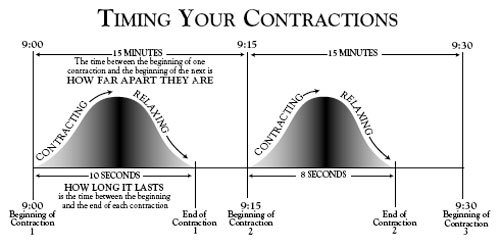A preterm birth is when the labor and delivery of a baby occurs between pregnancy weeks 20 to 37. According to the World Health Organization, preterm labor occurs in 12 percent of births. The most common causes of preterm labor are infection or an issue within the uterus. However, a poor maternal diet, certain environmental pollutants, and lack of prenatal care are also associated with preterm labor. Because preterm birth can have dire health consequences for the baby, it is important for mothers to be aware of the warning signs. African American women have higher rates of preterm labor than any other racial group. It’s often recommended that high risk pregnant women self-monitor their contractions for at least one full hour every morning and evening. This means feeling the abdomen for episodes of tightness, and noting any cramping sensations. When experiencing uterine contractions, it is important to record the timing of them. Contractions that occur every 10 minutes for more than an hour are sign of labor. (Read here for more about preventing preterm birth and preterm labor.)
Your doctor will explain when and how often to begin monitoring for contractions. This involves measuring their length of time, how far apart they are, and the number of contractions per hour. Rather than trust your memory or try to guess, t is better to have pen and paper handy, and a watch or a timer. If you become upset or worried while checking for contractions, you may be unable to remember all of the details. To make things easier, download our contractions worksheet. Continue reading to learn how to check for contractions.

Steps for Self-monitoring Contractions:
1) Empty your bladder to reduce any pressure on your uterus.
2) Drink one to two 8-ounce glasses of water; dehydration increases the level of the hormones that can lead to contractions.
3) Lie down on your left side with a pillow at your back. Don’t lie on your back. Doing so may cause more frequent contractions.
4) Spread your fingertips across the top of your abdomen, just below the rib cage. Press in lightly, and feel for any tightening inside your abdomen.
What will I feel with my hands and fingers?
Contractions usually begin at the top of the uterus (above your belly button), and feel like a tightening or hardening of a muscle. Your uterus will feel more firm as the contraction increases to a peak, then become relaxed as the contraction ends. If, with your fingertips, you feel this abdominal tightening followed by it softening, you’re having a contraction. It may even be visible as you look at your belly.
The uterus is a muscle. As it contracts, it becomes firm under your fingertips, similar to how your biceps feel when you “make a muscle” with your arm. During a contraction, the whole uterus should feel hard. Spreading your fingers allows you to feel a larger area. If there is only a localized “hard spot,” it is likely the baby’s buttocks or a foot, not a uterine contraction.

Timing Contractions
Each time you experience a contraction, count how many seconds it lasts. When it passes, write down the time, and how many seconds the contraction lasted. If you have more than four contractions in one hour, empty your bladder again, drink at least two 8-ounce glasses of water, and monitor for a second hour. If the contractions become more frequent or painful, call your doctor.
How long do contractions last?
The length of a contraction is usually measured in seconds. Begin counting the seconds at the onset of the contraction, (the uterus starts getting hard) and stop counting when the contraction ends (the uterus is soft and has completely relaxed). To make things easier, you may want to download a “contraction counter” app onto your smart phone, or use a digital timer. If none of these are available, a watch with a second hand will work just as well.
How far apart are my contractions?
The time between contractions is measured in minutes. “How far apart your contractions are” refers to the time between the onset of one contraction, and that of the next one. For example, if your first contraction begins at 9:00 and the next begins at 9:15, your contractions are 15 minutes apart. If contractions occur at 9:00, 9:15, 9:30, 9:45, and 10:00, then you have had four contractions in one hour. These contractions are considered “regular” because they happened every 15 minutes.
What to Do
“False labor,” known as Braxton Hicks contractions, are normal during the second and third trimesters of pregnancy. Unlike preterm labor, these contractions are mild, and only occur on a localized area of the uterus. These contractions are called “false labor” because they do not cause the cervix to expand (dilation) or thin out (effacement). These contractions are usually irregular, associated with only mild pain, and resolve within an hour or so with rest. To distinguish Braxton Hicks contractions from preterm labor, record the number and frequency of contractions in an hour. If you have regular contractions four times every 20 minutes, or eight times an hour that continue, call your doctor’s office right away. Research shows that preterm births can be prevented when contractions are monitored at home, especially prior to 34 weeks.